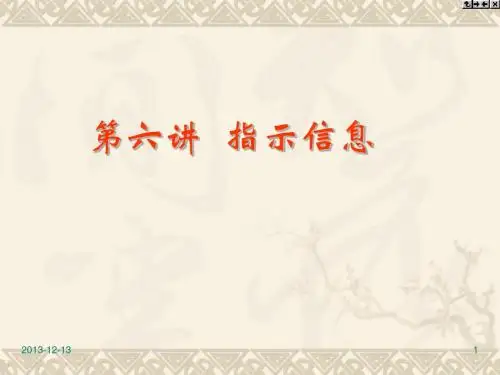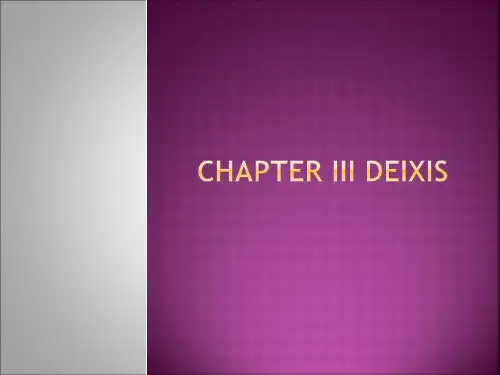Deixis指示语ppt课件
- 格式:docx
- 大小:329.86 KB
- 文档页数:2
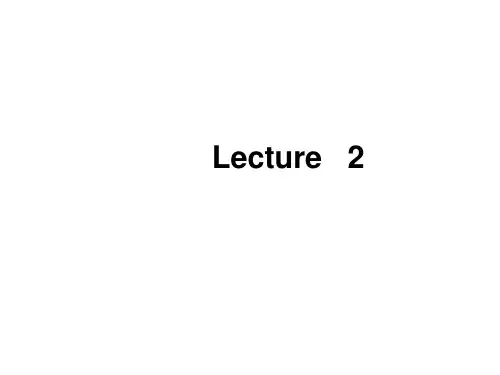
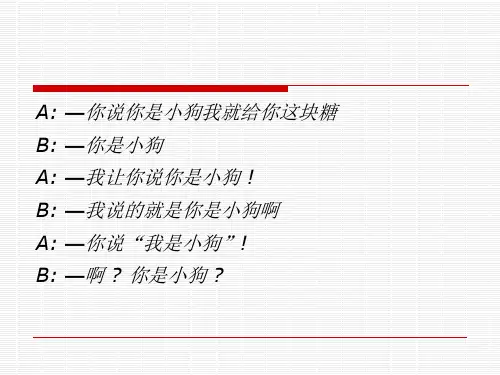
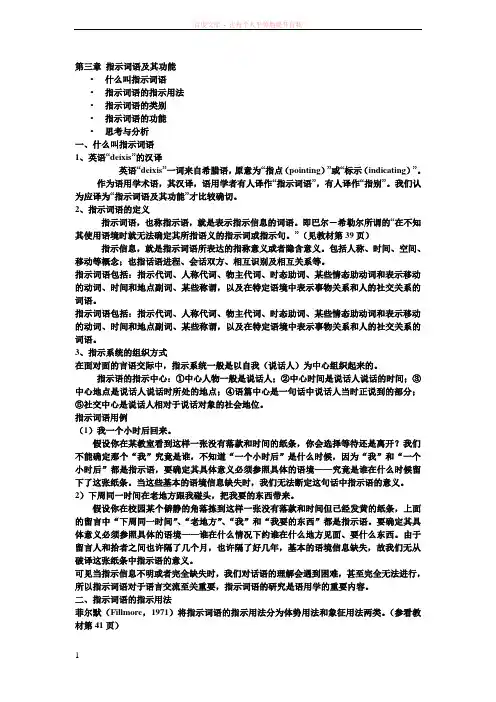
第三章指示词语及其功能•什么叫指示词语•指示词语的指示用法•指示词语的类别•指示词语的功能•思考与分析一、什么叫指示词语1、英语“deixis”的汉译英语“deixis”一词来自希腊语,原意为“指点(pointing)”或“标示(indicating)”。
作为语用学术语,其汉译,语用学者有人译作“指示词语”,有人译作“指别”。
我们认为应译为“指示词语及其功能”才比较确切。
2、指示词语的定义指示词语,也称指示语,就是表示指示信息的词语。
即巴尔-希勒尔所谓的“在不知其使用语境时就无法确定其所指语义的指示词或指示句。
”(见教材第39页)指示信息,就是指示词语所表达的指称意义或者隐含意义。
包括人称、时间、空间、移动等概念;也指话语进程、会话双方、相互识别及相互关系等。
指示词语包括:指示代词、人称代词、物主代词、时态助词、某些情态助动词和表示移动的动词、时间和地点副词、某些称谓,以及在特定语境中表示事物关系和人的社交关系的词语。
指示词语包括:指示代词、人称代词、物主代词、时态助词、某些情态助动词和表示移动的动词、时间和地点副词、某些称谓,以及在特定语境中表示事物关系和人的社交关系的词语。
3、指示系统的组织方式在面对面的言语交际中,指示系统一般是以自我(说话人)为中心组织起来的。
指示语的指示中心:①中心人物一般是说话人;②中心时间是说话人说话的时间;③中心地点是说话人说话时所处的地点;④语篇中心是一句话中说话人当时正说到的部分;⑤社交中心是说话人相对于说话对象的社会地位。
指示词语用例(1)我一个小时后回来。
假设你在某教室看到这样一张没有落款和时间的纸条,你会选择等待还是离开?我们不能确定那个“我”究竟是谁,不知道“一个小时后”是什么时候,因为“我”和“一个小时后”都是指示语,要确定其具体意义必须参照具体的语境——究竟是谁在什么时候留下了这张纸条。
当这些基本的语境信息缺失时,我们无法断定这句话中指示语的意义。
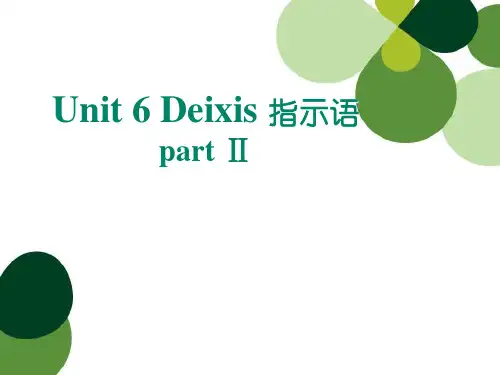
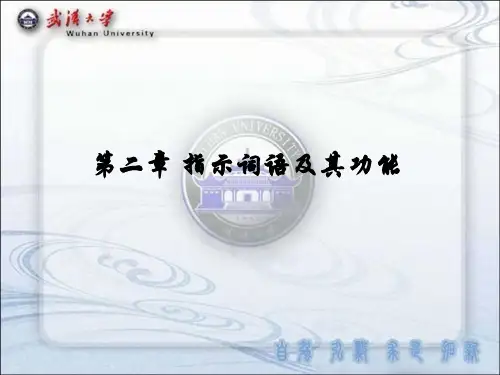
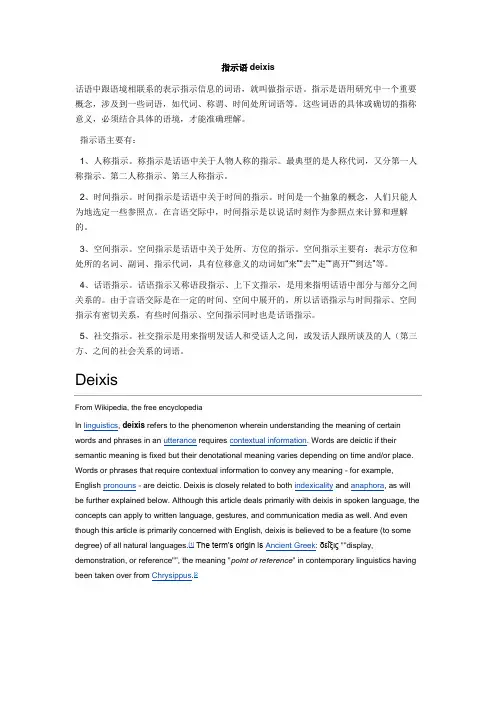
指示语deixis话语中跟语境相联系的表示指示信息的词语,就叫做指示语。
指示是语用研究中一个重要概念,涉及到一些词语,如代词、称谓、时间处所词语等。
这些词语的具体或确切的指称意义,必须结合具体的语境,才能准确理解。
指示语主要有:1、人称指示。
称指示是话语中关于人物人称的指示。
最典型的是人称代词,又分第一人称指示、第二人称指示、第三人称指示。
2、时间指示。
时间指示是话语中关于时间的指示。
时间是一个抽象的概念,人们只能人为地选定一些参照点。
在言语交际中,时间指示是以说话时刻作为参照点来计算和理解的。
3、空间指示。
空间指示是话语中关于处所、方位的指示。
空间指示主要有:表示方位和处所的名词、副词、指示代词,具有位移意义的动词如“来”“去”“走”“离开”“到达”等。
4、话语指示。
话语指示又称语段指示、上下文指示,是用来指明话语中部分与部分之间关系的。
由于言语交际是在一定的时间、空间中展开的,所以话语指示与时间指示、空间指示有密切关系,有些时间指示、空间指示同时也是话语指示。
5、社交指示。
社交指示是用来指明发话人和受话人之间,或发话人跟所谈及的人(第三方、之间的社会关系的词语。
DeixisFrom Wikipedia, the free encyclopediaIn linguistics, deixis refers to the phenomenon wherein understanding the meaning of certain words and phrases in an utterance requires contextual information. Words are deictic if their semantic meaning is fixed but their denotational meaning varies depending on time and/or place. Words or phrases that require contextual information to convey any meaning - for example, English pronouns - are deictic. Deixis is closely related to both indexicality and anaphora, as will be further explained below. Although this article deals primarily with deixis in spoken language, the concepts can apply to written language, gestures, and communication media as well. And even though this article is primarily concerned with English, deixis is believed to be a feature (to some degree) of all natural languages.[1]The term’s origin is Ancient Greek: δεῖξις ""display, demonstration, or reference"", the meaning "point of reference" in contemporary linguistics having been taken over from Chrysippus.[2Types of deixis[edit]Traditional categoriesPossibly the most common categories of contextual information referred to by deixis are those of person, place, and time - what Fillmore calls the “major grammaticalized types” of deixis.[3] [edit]PersonPerson deixis concerns itself with the grammatical persons involved in an utterance, (1) those directly involved (e.g. the speaker, the addressee), (2) those not directly involved (e.g. overhearers—those who hear the utterance but who are not being directly addressed), and (3) those mentioned in the utterance.[4] In English, the distinctions are generally indicated by pronouns. The following examples show how. (The person deictic terms are in italics [a signaling notation that will continue through this article].)I am going to the movies.Would you like to have dinner?They tried to hurt me, but he came to the rescue.GenderIn many languages, that only have male and female, referring to gender neutral subjects has different aspects. Objects , or things have their own gender too between male or female. When referring to a genderless object, it is often referred to as a male, though the object is genderless. In the English language, when referring to any character that has no gender, a self-aware entity, it is referred to a male, or as a "He", such as an "it" is inappropriate when calling the sentient object a thing. In many languages, they would address to people as in male, such as a group mixed with men and women is referred to as a male, such as Ils in French. An example would be :A man is responsible for his own soulas opposed toEach person is responsible for his or her own soulcommon in many religious text referring to people of all genders using only the male gender. This can be understood in context, the male gender being used to signify male or female persons.PlacePlace deixis, also known as space deixis, concerns itself with the spatial locations relevant to an utterance. Similarly to person deixis, the locations may be either those of the speaker and addressee or those of persons or objects being referred to. The most salient English examples are the adverbs“here” and “there”and the demonstratives“this” and “that” - although those are far from being the only deictic words.[3]Some examples:I enjoy living in this city.Here is where we will place the statue.She was sitting over there.Unless otherwise specified, place deictic terms are generally understood to be relative to the location of the speaker, as inThe shop is across the street.where “across the street” is understood to mean “across the street from where I am right now.”[3] It is interesting to note that while “here” and “there” are often used to refer to locations near to and far from the speaker, respectively, “there” can also refer to the location of the addressee, if they are not in the same location as the speaker. So, whileHere is a good spot; it is too sunny over there.exemplifies the former usage,How is the weather there?is an example of the latter.[4]Languages usually show at least a two-way referential distinction in their deictic system: proximal, i.e. near or closer to the speaker, and distal, i.e. far from the speaker and/or closerto the addressee. English exemplifies this with such pairs as this and that, here and there, etc. In other languages, the distinction is three-way: proximal, i.e. near the speaker, medial, i.e. near the addressee, and distal, i.e. far from both. This is the case in a few Romance languages and in Korean, Japanese, Thai, Filipino and Turkish The archaic Englishforms yon and yonder (still preserved in some regional dialects) once represented a distal category which has now been subsumed by the formerly medial "there".[5]TimeTime, or temporal, deixis concerns itself with the various times involved in and referred to inan utterance. This includes time adverbs like "now", "then", "soon", and so forth, and also different tenses. A good example is the word tomorrow, which denotes the consecutive next day after every day. The "tomorrow" of a day last year was a different day than the "tomorrow" of a day next week. Time adverbs can be relative to the time when an utterance is made (what Fillmore calls the "encoding time", or ET) or when the utterance is heard (Fillmore’s "decoding time", or DT).[3] While these are frequently the same time, they can differ, as in the case of prerecorded broadcasts or correspondence. For example, if one were to writeIt is raining out now, but I hope when you read this it will be sunny.the ET and DT would be different, with the former deictic term concerning ET and the latterthe DT.Tenses are generally separated into absolute (deictic) and relative tenses. So, forexample, simple English past tense is absolute, such as inHe went.while the pluperfect is relative to some other deictically specified time, as inHe had gone.Other categoriesThough the traditional categories of deixis are perhaps the most obvious, there are other types of deixis that are similarly pervasive in language use. These categories of deixis were first discussed by Fillmore and Lyons.[4][edit]DiscourseDiscourse deixis, also referred to as text deixis, refers to the use of expressions within an utterance to refer to parts of the discourse that contains the utterance — including the utterance itself. For example, inThis is a great story.“this” refers to an upcoming portion of the discourse, and inThat was an amazing day.that” refers to a prior portion of the discourse.Distinction must be made between discourse deixis and anaphora, which is when an expression makes reference to the same referent as a prior term, as inMatthew is an incredible athlete; he came in first in the race.Lyons points out that it is possible for an expression to be both deictic and anaphoric at the same time. In his exampleI was born in London and I have lived here/there all my life.“here” or “there” function anaphorically in their refe rence to London, and deictically in that the choice between “here” or “there” indicates whether the speaker is or is not currently in London.[1]The rule of thumb to distinguish the two phenomenon is as follows: when an expression refers to another linguistic expression or a piece of discourse, it is discourse deictic. When that expression refers to the same item as a prior linguistic expression, it is anaphoric.[4]Switch reference is a type of discourse deixis, and a grammatical feature found in some languages, which indicates whether the argument of one clause is the same as the argument of the previous clause. In some languages, this is done through same subject markers and different subject markers. In the translated example "John punched Tom, and left-[samesubject marker]," it is John who left, and in "John punched Tom, and left-[different subject marker]," it is Tom who left.[citation needed][edit]SocialSocial deixis concerns the social information that is encoded within various expressions, such as relative social status and familiarity. Two major forms of it are the so-called T-V distinctions and honorifics.Usages of deixisIt is helpful to distinguish between two usages of deixis, gestural and symbolic, as well asnon-deictic usages of frequently deictic words. Gestural deixis refers, broadly, to deictic expressions whose understanding requires some sort of audio-visual information. A simple example is when an object is pointed at and referred to as “this” or “that”. However, the category can include other types of information than pointing, such as direction of gaze, tone of voice, and so on. Symbolic usage, by contrast, requires generally only basic spatio-temporal knowledge of the utterance.[4] So, for exampleI broke this finger.requires being able to see which finger is being held up, whereasI love this city.requires only knowledge of the current location. In a similar vein,I went to this city one time . . .is a non-deictic usage of "this", which does not reference anything specific.Rather, it is used as an indefinite article, much the way "a" could be used inits place.。
